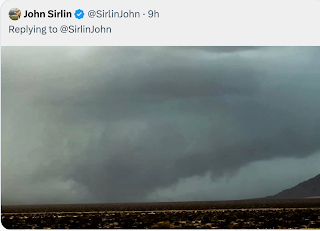"As Time Goes on a Link Between Decreasing Solar Activity and the Halt in Global Warming 17-Years Ago Becomes Harder and Harder To Deny"
The monthly International Sunspot Number from the Solar Information Data Center (SIDC) of the Royal Observatory of Belgium was released December 1st. It fell to 77.6 spots/day.
Most newsworthy is that this is still the weakest solar max in over 200 years, well below NASA’s forecast.
Details here.
Here is a graph of the sun's activity versus what NOAA's Space Weather Prediction Center forecast in 2006:
Clearly, the level of sunspots was far, far below the forecast.
Below is a graph I plotted using the WoodforTrees.org tool. It shows flat to falling temperatures as carbon dioxide continues its steady increase.
The graph begins in 1997 and shows the concentration of carbon dioxide (red) and the Hadley Center's earth temperature data (the same data used by the IPCC).
It is the Al Gore/IPCC contention that CO2 concentration is the driving force in climate. In fact, a guest from the NOAA Space Weather Prediction Center recently stated on the "Barometer Bob Show" that there was no correlation between changes in the sun's activity and climate.
Question: If the "consensus" in climate science is true (changes in solar energy do not affect climate while CO2 is climate change's driving force), how do you account for the downward trend in temperatures? As concentration of CO2 has risen to near 400 parts per million, the rate of temperature increase was supposed to rise. Instead, temperatures are level to slightly falling.
This is what is called, in genuine science, a falsified hypothesis.
Doesn't CO2, other factors equal, cause earth's temperatures to warm? Yes, but at an ever-decreasing rate. When I was studying atmospheric physics in 1974, we learned that the affect of CO2 on temperature was logarithmic (see blue line on graph below).
Think of the above in this way:
Here is a graph of the sun's activity versus what NOAA's Space Weather Prediction Center forecast in 2006:
Clearly, the level of sunspots was far, far below the forecast.
Below is a graph I plotted using the WoodforTrees.org tool. It shows flat to falling temperatures as carbon dioxide continues its steady increase.
The graph begins in 1997 and shows the concentration of carbon dioxide (red) and the Hadley Center's earth temperature data (the same data used by the IPCC).
It is the Al Gore/IPCC contention that CO2 concentration is the driving force in climate. In fact, a guest from the NOAA Space Weather Prediction Center recently stated on the "Barometer Bob Show" that there was no correlation between changes in the sun's activity and climate.
Question: If the "consensus" in climate science is true (changes in solar energy do not affect climate while CO2 is climate change's driving force), how do you account for the downward trend in temperatures? As concentration of CO2 has risen to near 400 parts per million, the rate of temperature increase was supposed to rise. Instead, temperatures are level to slightly falling.
This is what is called, in genuine science, a falsified hypothesis.
Doesn't CO2, other factors equal, cause earth's temperatures to warm? Yes, but at an ever-decreasing rate. When I was studying atmospheric physics in 1974, we learned that the affect of CO2 on temperature was logarithmic (see blue line on graph below).
Think of the above in this way:
- Suppose you had a hot tub and wanted to trap the heat to keep the water warm. A great way would be to put an inch of insulting material over it. You could trap even more heat with a second inch. But, by the time you got to the, say, 23rd inch, it would have nowhere near as much heat-trapping effect as the first inch. That is a logarithmic effect.
So, going from 380 to 400 parts per million (ppm) will have less heat trapping properties than going from 320 to 340ppm. The pro-catastrophic global warming advocates counter with "feedbacks" (i.e., as temperatures rise, changes in clouds will further warm the earth) they claim will magnify the otherwise leveling logarithmic effect. However, many of those feedbacks have since been shown to have less additional warming effect or no warming effect at all.
A new hypothesis is that prolonged periods of low sunspot numbers (for unknown reasons) have a cooling effect on earth's climate and that rising CO2's effect is small (not zero).
Science has little or no ability to forecast future sunspot values as the busted NOAA 2006 forecast demonstrates. If those who believe we are entering an era of prolonged, very low levels of sunspots are correct, then mild to major cooling may occur on earth. History clearly demonstrates that cold temperatures are worse for humanity than warm temperatures.
It is past time to start putting major resources into learning to forecast sunspot values and the effect they have on climate. The lives and future prosperity of the world may depend on it.
Where will the money come from? I suggest major cuts to what we are spending on global warming.
So far, the U.S. has spent around $165,000,000,000 on global warming studies and for that investment we have learned that global warming causes brothels to struggle while, at the same time, it pushes women into prostitution. It causes beer to be better and be worse. Instead of continuing to spend money on first class airfare and 5-star hotels for global warming conferences (Bali, Cancun, Coppenhagen), it is time to start studying what appears to be a major, and growing, threat. Perhaps climate scientists in the 1970's were right after all. Global cooling may be what we really should be worried about after all.







Comments
Post a Comment